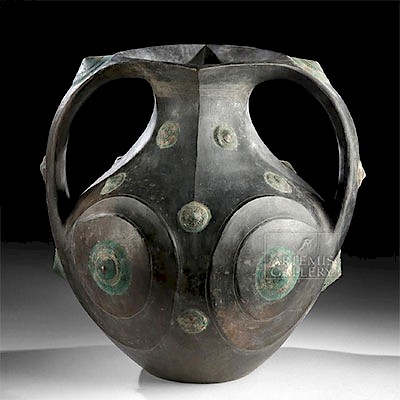Sassanian Glass Bowl - Facet Cut
Lot 84
About Seller
Artemis Gallery
686 S Taylor Ave, Ste 106
Louisville, CO 80027
United States
Selling antiquities, ancient and ethnographic art online since 1993, Artemis Gallery specializes in Classical Antiquities (Egyptian, Greek, Roman, Near Eastern), Asian, Pre-Columbian, African / Tribal / Oceanographic art. Our extensive inventory includes pottery, stone, metal, wood, glass and textil...Read more
Estimate:
$900 - $1,400
Absentee vs Live bid
Two ways to bid:
- Leave a max absentee bid and the platform will bid on your behalf up to your maximum bid during the live auction.
- Bid live during the auction and your bids will be submitted real-time to the auctioneer.
Bid Increments
| Price | Bid Increment |
|---|---|
| $0 | $25 |
| $300 | $50 |
| $1,000 | $100 |
| $2,000 | $250 |
| $5,000 | $500 |
| $10,000 | $1,000 |
| $20,000 | $2,500 |
| $50,000 | $5,000 |
| $100,000 | $10,000 |
| $200,000 | $20,000 |
About Auction
By Artemis Gallery
Jul 11, 2019
Set Reminder
2019-07-11 10:00:00
2019-07-11 10:00:00
America/New_York
Bidsquare
Bidsquare : Ancient / Ethnographic / Americana
https://www.bidsquare.com/auctions/artemis-gallery/ancient-ethnographic-americana-4246
Discover ancient art from Egypt, Greece, Italy, and the Near East, as well as Asian, Pre-Columbian, Tribal, Fossils and Fine Art. Also featuring a wonderful collection from a prominent New York estate whose owners reside in the Van Wyck family's historic Lloyd Harbor waterfront home. Artemis Gallery info@artemisgallery.com
Discover ancient art from Egypt, Greece, Italy, and the Near East, as well as Asian, Pre-Columbian, Tribal, Fossils and Fine Art. Also featuring a wonderful collection from a prominent New York estate whose owners reside in the Van Wyck family's historic Lloyd Harbor waterfront home. Artemis Gallery info@artemisgallery.com
- Lot Description
Ancient Near East/Central Asia, Sasanian (Sassanian/Sassanid) Empire, ca. 2nd to 7th century CE. A gorgeous mold-made aqua blue glass cup with a thick-walled hemispheric body adorned by meticulously spaced circular facets. A large and deeply cut facet on the base provides a stable surface upon which it rests. These facets create a sparkling effect when held to the light. Pearlescent deposits on the interior and exterior show the passage of time on the piece. Size: 3.55" W x 2.8" H (9 cm x 7.1 cm)
Faceted bowls such as this one are characterized by uniformity of shape, size, and arrangement of the facets in four or five rows. They represent the most widespread type of late Sasanian glass vessel, found in excavations of Mesopotamian and Iranian sites dating from the fifth to seventh century CE. Some examples, probably carried along the Silk Road to the Far East by Persian merchants and traveling embassies, have been found in Japanese contexts, notably in the sixth-century tomb of the emperor Ankan and in the Shoso-in Treasure at Nara, which was assembled by the emperor Shomu in the eighth century.
Provenance: private East Coast, USA collection
All items legal to buy/sell under U.S. Statute covering cultural patrimony Code 2600, CHAPTER 14, and are guaranteed to be as described or your money back.
A Certificate of Authenticity will accompany all winning bids.
We ship worldwide and handle all shipping in-house for your convenience.
#139744Intact, with pearlescent deposits. The surface is pitted, with a surface hairline fracture on its interior that does not threaten the integrity of the piece.Condition
- Shipping Info
-
All shipping is handled in-house for your convenience. Your invoice from Artemis Gallery will include shipping calculation instructions. If in doubt, please inquire BEFORE bidding for estimated shipping costs for individual items.
-
- Buyer's Premium



 EUR
EUR CAD
CAD AUD
AUD GBP
GBP MXN
MXN HKD
HKD CNY
CNY MYR
MYR SEK
SEK SGD
SGD CHF
CHF THB
THB
















